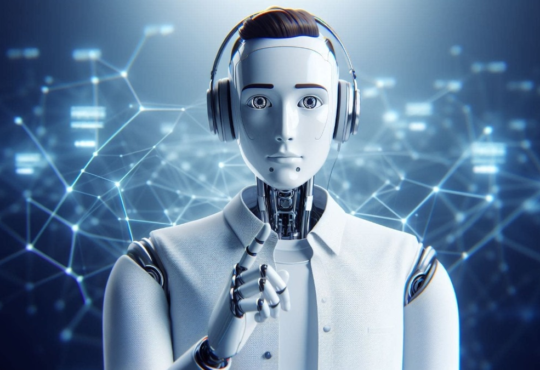More countries across Asia are debuting digital artificial intelligence news readers. Could Australia follow suit? – ABC News

More countries across Asia are debuting digital artificial intelligence news readers. Could Australia follow suit?
Fahada Indi was breast pumping in the middle of a crowded fair in Jakarta when her boss asked her to present the news right then and there.
Not long after, an avatar who looked like Indi appeared in the TVOne studio, one of the major television networks in Indonesia.
But the name that appeared on-screen wasn't Indi's.
It was Nadira, an avatar created by TVOne using artificial intelligence (AI) technology.
"With this AI technology, I can read the news anywhere, then my avatar appears," Indi told the ABC.
TVOne, which introduced Nadira and another AI news anchor, Sasya, in April, is the first network in Indonesia to use the controversial technology in this way.
But Nadira and Sasya are among several digital AI news bots that have recently started reading bulletins in countries across Asia, often to help cater to diverse cultural and linguistic needs.
China became the first country in the world to introduce AI news presenters in 2018, with a pair of suit-wearing men delivering a bulletin for China's state-run Xinhua news agency — one speaking Chinese and the other speaking English.
India followed in April this year, launching the AI-powered anchor Sana at an event attended by Prime Minister Narendra Modi.
She now presents bulletins several times a day on the India Today Group's Aaj Tak news channel.
The media group's vice-chairperson has described the digital humanoid bot as "bright, gorgeous, ageless, tireless".
Rather than being an avatar of an existing newsreader, Sana was created with her own image and personality.
"Chuffed to be 1st AI anchor for AajTak. Sports & puzzles enthusiast," Sana's Twitter biography says.
"Can share failed recipes. Travel, path less taken. Unapologetically myself!"
Last weekend, a second AI news presenter made its debut in India, appearing on the private news channel in Odisha, presenting bulletins in English and Odia – a language spoken in the state.
And since last month, Taiwan's FTV News has had an AI weather presenter.
While some Asian countries seem to be embracing opportunities to use AI in the media landscape, Australians may not be as welcoming of its use.
A new survey by market research firm Ipsos Global Advisor this week found Australians were the most worried about AI out of the 31 countries examined.
The Global Views on AI 2023 survey revealed that 69 per cent of Australian respondents said they were nervous about the technology.
Australians also lagged behind people in most countries in their understanding of the use of AI in different types of products and services, according to the study.
Meanwhile, Indonesians were among the most confident, with 48 per cent saying AI made them nervous.
The Japanese were the least nervous, with just 23 per cent of adults indicating concern.
There has been a lot of recent commentary about the negative impacts of AI in the media, ranging from potential mass unemployment to misinformation running wild.
TVOne's AI program consultant, Apni Jaya Putra, said they were trying to strike a balance by not completely relying on the technology in presenter roles.
Mr Putra told the ABC that technology had made it possible to clone voices so that the broadcast could be "100 per cent" driven by AI.
But he said the network decided to keep the presenters' real voices to ensure greater accuracy and prevent technology from leading to job losses.
"We have feelings that cannot be replaced by AI," Indi said.
"We have intonation and emotion, so the AI presenters who come out are not flat."
Indi said incorporating AI had made her work easier because she could read the news from anywhere.
She can make a recording of her voice, send it to the studio team, and in seconds Nadira can be seen speaking in her voice.
Even when recording among crowds at the fair, "the noise was still there, but the AI team managed to eliminate it", Indi said.
Another advantage of using AI is that it can reach a wider audience by translating her voice into different languages using the voice cloning feature, Indi said.
TVOne generally uses another AI technology to check language translations, according to Mr Putra.
Albertus Prestianta, a digital media observer at the Queensland University of Technology, warned this was where things could get problematic.
Voice cloning using AI is one of the features that is feared to breed misinformation as its accuracy cannot be guaranteed.
Language is a cultural product, and every cultural product must have a social and cultural context, Mr Prestianta says.
"I think there still needs to be a linguist recruited to make sure the context is appropriate," he told the ABC.
While Mr Prestianta was encouraging of TVOne's innovation, he said: "This technology must still be used and controlled by humans."
"So the decision-makers are the humans."
Mr Prestianta also raised concerns about being able to verify AI-generated news content.
Chinese state-aligned actors are using AI-generated deepfake news broadcasters to peddle pro-China propaganda videos for social media platforms, a new research report claims.
Lately, the world has been grappling with how to deal with an increasing number of online deepfakes imitating everyone from news presenters to politicians.
Deepfakes are manipulated and altered images, video or audio that are used to misrepresent someone doing or saying something that is not real.
Last February, Chinese state-aligned actors reportedly used AI-generated deepfake news broadcasters to peddle pro-China propaganda videos for social media platforms.
Mr Prestianta said deepfakes were unavoidable in the era of rapidly developing technology, but education and digital literacy could help.
Although Australia has the technology to start using AI in different media aspects, news organisations are still treading carefully, according to James Meese, senior media and communications lecturer at the Royal Melbourne Institute of Technology.
As ChatGPT comes under increasing scrutiny, one Victorian country newspaper is already using artificial intelligence to fill column space.
"Australian newsrooms are in the early stages of engaging with artificial intelligence, but it is definitely on their radar," he said.
"Strategies are being put in place to incorporate these technologies more effectively, but companies are conscious of the risks involved and are carefully weighing up the pros and cons before moving ahead."
The Guardian has said generative AI tools are "exciting but are currently unreliable".
Guardian News & Media has set up an AI working group to assess how it should respond to the risks and opportunities posed by the technology.
"If we wish to include significant elements generated by AI in a piece of work, we will only do so with clear evidence of a specific benefit, human oversight, and the explicit permission of a senior editor," chief executive Anna Bateson and Guardian editor-in-chief Katharine Viner said in a joint statement last month.
"We will be open with our readers when we do this."
The ABC's news standards editor, Matt Brown, said the organisation currently had no definite plans to use AI in its reporting.
But he said it was "looking at the technology and thinking very carefully" about how the ABC could use the technology.
"There's no plan to use an AI generative sort of image or voice to present the news," he said.
"Our primary concern with AI is the same as our primary concern in anything else. And that is accuracy, impartiality, doing our best job in the interest of our community."
The ABC understands that the Nine Network has ruled out the use of AI for news bulletins and stories, instead using it to create additional content such as sports highlights packages.
While more traditional media outlets are taking a cautious approach, The Brag Media, which touts itself as being "at the centre of youth culture", has welcomed the opportunity to experiment with AI to write articles.
"Just as the invention of the calculator didn't devalue mathematicians, and Photoshop didn't devalue the artist, AI writing won't devalue the journalists and news writers," CEO Luke Girgis wrote in a LinkedIn post in January.
David Elliott, Ipsos Australia director, said AI had long had an image problem in Australia and for confidence to grow there would need to be more education about its use and how it worked.
"There's a need for mass education around the technology, particularly its potential in increasing workplace efficiencies and improving day-to-day life," he said.
Additional reporting by Annika Burgess
We acknowledge Aboriginal and Torres Strait Islander peoples as the First Australians and Traditional Custodians of the lands where we live, learn, and work.
This service may include material from Agence France-Presse (AFP), APTN, Reuters, AAP, CNN and the BBC World Service which is copyright and cannot be reproduced.
AEST = Australian Eastern Standard Time which is 10 hours ahead of GMT (Greenwich Mean Time)







